When I read The Painted Bird by Jerzy Kosiński, it disturbed me, in that special way that only great literature can. It tore my brain up, left me feeling very uncertain about who I was, about my own species. This music just had to come out.

Seeking balance in a chaotic world
When I read The Painted Bird by Jerzy Kosiński, it disturbed me, in that special way that only great literature can. It tore my brain up, left me feeling very uncertain about who I was, about my own species. This music just had to come out.
I wrote this on a ranch. I wrote this at the radio station, late late at night. It’s a song of love. It’s a song about feeling alone.
On the day I finished it, I also finished On Chisel Beach by Ian McEwan. This music wrapped itself around that story, and both were planted deep into my brain. Both the music and that story complain and ache and worry, they both drag it out when it doesn’t need to be that complicated. Both improve with age, with patience, with repetition.
On the day I finished it, I drew this picture:

I also fretted about composing too slowly:

Writing words on sheet music is easier than writing music. Maybe I just need to write music as often as I write words.
This song reminds me of sitting up until all hours of the night, on a couch that wasn’t my own, in a strange house, watching WWII documentaries and checking to see if we’d accidentally let the coyote eat the cat.
It reminds me of the last grasping days of college. I was spending most of my time grasping, grasping at what?… grasping at something.
It reminds me of emerging from a dark cavern to greet the morning sun. It reminds me of waiting, waiting, waiting to grow up.
Years and years and years after I finished the music, I played it for someone. She said, “You’re really starting to get good at this.” I pretended that the music was truly new.
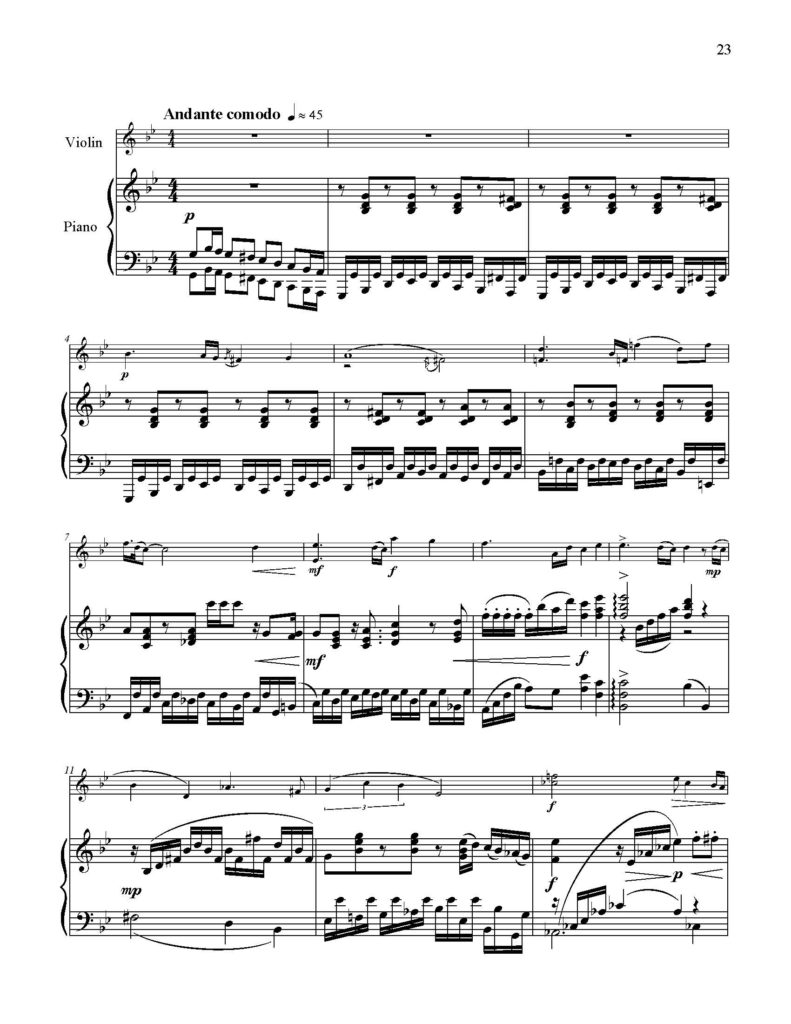
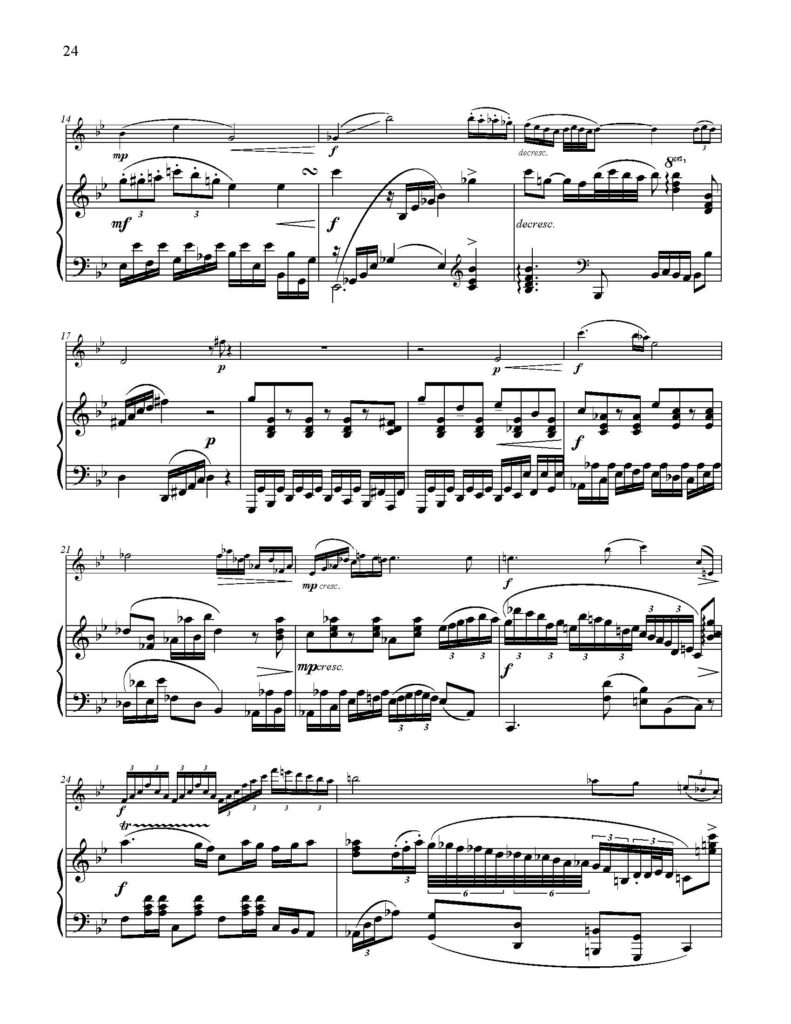
I created this song and video for my wife Erica for our ten year anniversary. It’s called “Marshmallow”.
In late 2017 I picked up Quiquern again and resolved to finish it for the last time. How many times had I called this project complete, only to pick it up again a year later and tinker, tinker? Well those days are done. If I can’t finish a project, like really finish it, how can I call myself a composer, or an artist for that matter? By the New Year had I hammered out the first fragment (now equipped with a Village Dance section) and finally turned the second fragment into a real piece, rather than just a collection of unconnected ideas.
In early January, full of fresh energy and creative juice, I saw the music in a different light and dove headfirst into some new material. In two days I created an entirely original fragment: The Singing House.
Come on a musical journey with me.
On the far side of the village is the Quaggi – The Singing House. Only men may enter; it is where they go to pray. In times of plenty, the men sing hearty songs of gratitude to the various gods of the Arctic. In times of desperation, they fall into a trance of smoke and dark and sweat and hunger. Arms linked, stomping the holy ground, repeating of the same syllables, the great hunters of the village reach for the gods with outstretched arms.
What does a 10 year old boy imagine of this place? Banned from entering, just like the women, but knowing in his heart, unlike the women, that one day he will be granted entry into the inner sanctum, a young boy of the village can only guess what goes on inside that large tent. He hears from a friend that the sorcerer sings his magic songs and calls upon the Spirit of the Reindeer, and his songs make the wind blow and the ice crack to reveal the seal below. Anxiety and yearning and fear wiggle through his body. One day he would take his place in the Quaggi and learn the secrets of the hunters.
I should also note that I openly plagiarized the work of another composer in this piece: David Wise, who wrote all the music from Donkey Country (1 and 2). Here’s the tune I stole:
So good right?
The music from this game was the running soundtrack of my childhood. When I was in middle school, I used to pretend I was in a band (perhaps in some jazzy night club) performing this very song. This music shaped me and my compositional style. I feel honored to sample this man’s music.
The form of “Quaggi” is reminiscent of video game music. The first section is a long musical segment consisting of variations on a couple themes. It then repeats. In fact it could repeat on loop and just BE video game music.
(Hit Ctrl+ to read this journal entry).
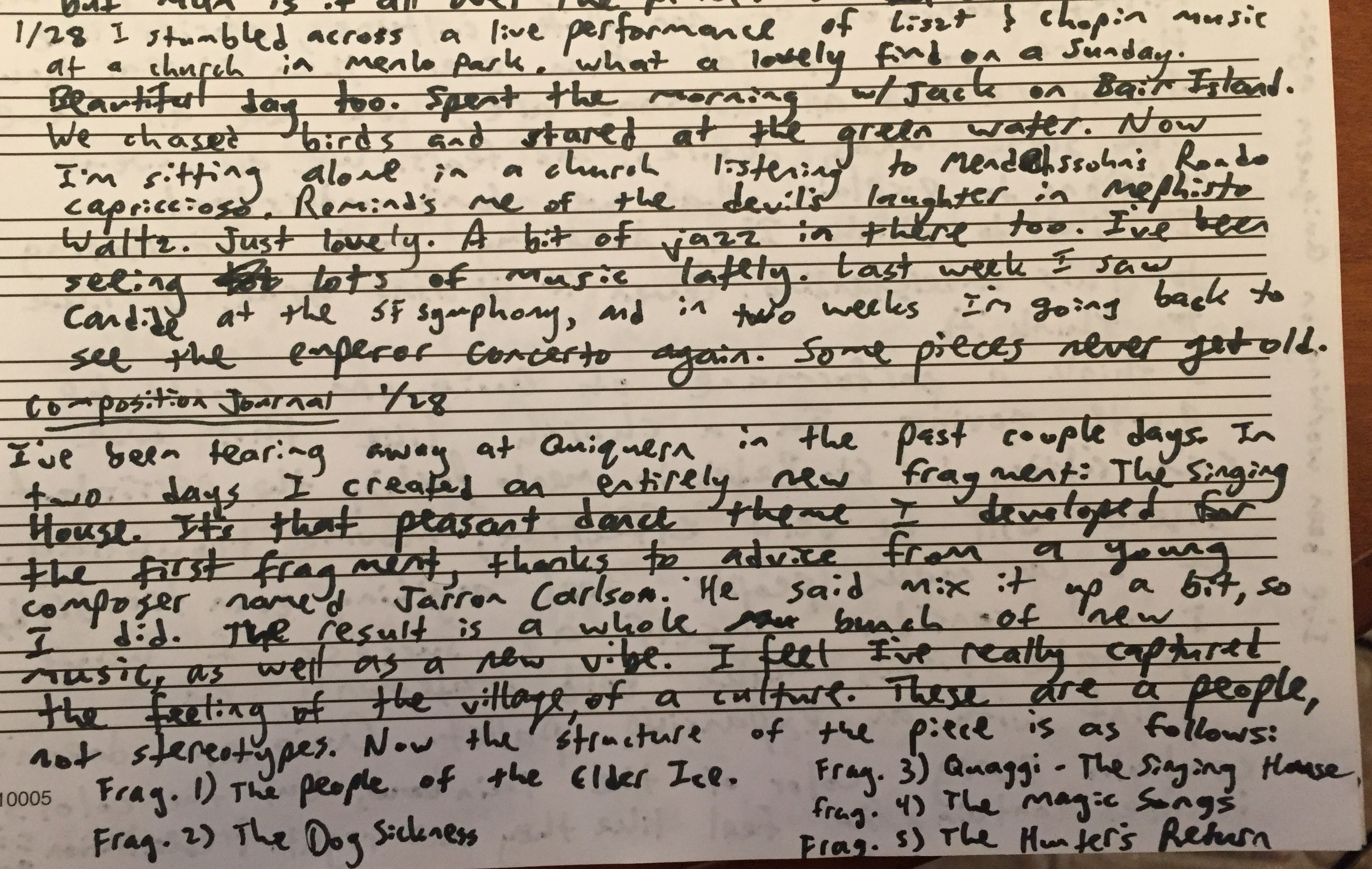
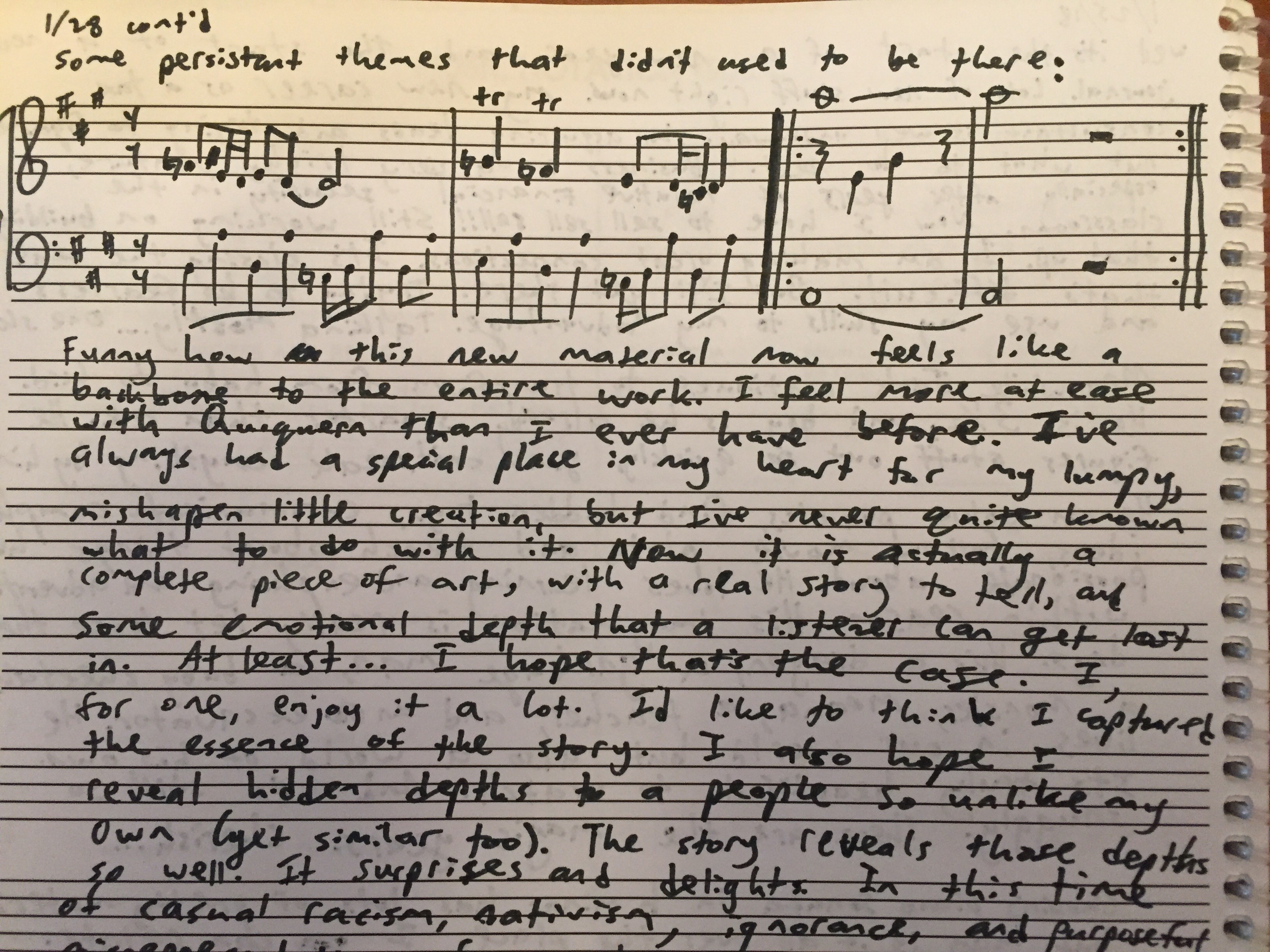

Here’s the piece I was listening to as I wrote this:
You can read more about Quiquern here.
Remember how I said a while back that the first movement of Quiquern was complete? Well that wasn’t the first time I’ve said that and been mistaken.
Here’s the new version:
I posted what I thought was a complete movement on a favorite forum of mine, the Young Composers Music Forum, (here’s the post). A young composer named Jarron Carlson posted a very thoughtful response:
“Thank you for sharing this (wonderfully poetic!!) music! I love your use of motifs and how creative you are with your harmonic language. Especially in the first movement, I really admire your use of more traditional harmonies how they slip into sonorities that are more modern-sounding. I do wish however, that you exposed us to more variety in texture in the first movement. I feel like most of the piece you stick to the feel of (for lack of a better word) intruding silences and pauses preceded by short melodic phrases. Maybe you were going for this feel throughout the whole movement, but I sort-of wish I got the chance to hear you develop your motivic ideas in a different kind of texture. Texture change can also be very effective for communicating different emotions to your audience (which I read was one of your goals in this piece and I feel like you’re already doing well already, with your writing as it is :)”
That critique really struck home. Quiquern has always been one of my children, and I love her dearly, but she has never been perfect. One persistent problem across the years has been a lack of diversity of sound. There are lots of lovely segments of Quiquern, but when taken together they tend to blend into something long and monochromatic (a touch of which I was going for, as I wrote the music picturing a frozen tundra, but too much can be too much). Throw in a new texture, mix in some beloved themes previously heard, and BOOM magic happens. A fire was lit! I mean shoot, I had enough material to work with!
By the way, you can check out some of Jarron’s work at his Soundcloud: https://soundcloud.com/jarron1099.
I don’t often compose quickly, but this stretch was fast. Statistically now it has been proven that I almost always very musically productive in late December. My Song-Writing Club took place in December, as have many feverish bouts of creative activity. I started the new section the evening I received the critique (Dec. 13), and completed the new section New Year’s Eve (Dec. 31). Just under 20 days to complete about seven minutes of new music; for me that’s pretty dang quick.
I took the main Quiquern theme and wove it a kind of lively folk dance, the piano strumming like a guitar, a people dancing in the firelight. The woodwinds play all sorts of little games together, chase each other across the ice. There is something festive about this music, but still somber. Just beyond the warmth of that fire is an endless frozen wilderness. It is bitterly cold out there, so cold a man’s skin can freeze off his bones, so cold you go mad. Something is lurking out there, in the distant dark. It could be a god or it could be a monster, or perhaps the wind. Right here, safe by the fire, with my family all around me, I am safe and warm. I celebrate that warmth and cherish it, while I still have it. I pray that all those who don’t have it may find it soon.
How to express a people through music… How to express all the depth of the human experience, all the moments and understandings shared among a tribe… It feels like an impossible task. But at least I feel I added another layer. I wanted these people to celebrate who they are in this music, to have a little fun, to play and wrestle and love. At the edge of the world, surrounded by danger, I wanted them to dance.
The image on this page is my an artist named Milo Minock, who meticulously documented the goings-on of the Yup’ik tribe in the 1950s and 60s. Read about his work here.
Today I finally completed part two of my piece called “Quiquern.” This movement is called “The Dog Sickness”. (Click here for part one).
I thought “Quiquern” was complete years ago. Time and again I would declare it officially finished. But then, months later, something just wouldn’t sit right with me. I’d pry it open again and tinker with its innards. Maybe it will never be done. Maybe I’m destined to dance with this score til the end of my days.
Don’t get me wrong, I have always loved this music. Every time I pick it up again, I’m reminded of why I have such a sweet spot in my heart for “Quiquern”. It evokes so many positive memories: of writing it over Christmas break in San Diego, of reading The Jungle Book over and over, of experimenting with new sounds (new to me anyways), of unhinging my creativity from purely classical harmonies and letting go a bit. Like this sort of thing:
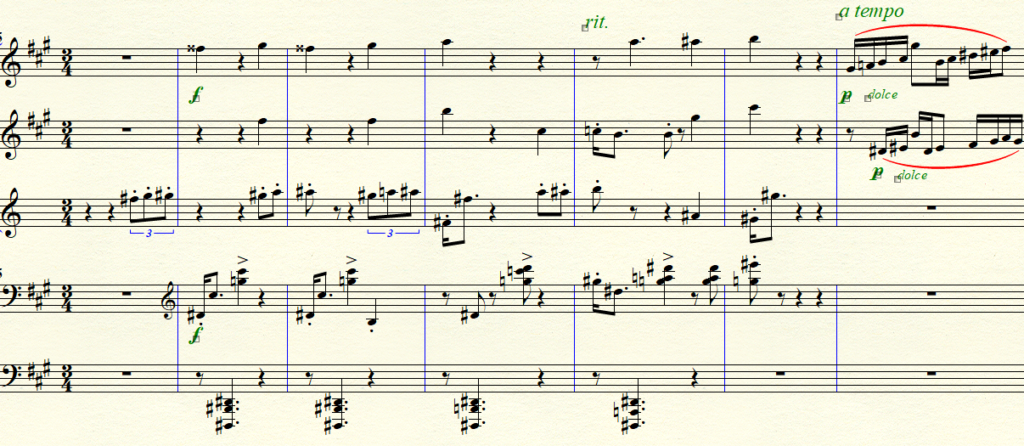
I never go full atonal, I’m always chained in some way to classical forms and progressions, but this piece freed me up in some ways I had never tried. I went wandering a bit through the cold wilderness. I let the images in my mind solidify into a color palette. I focused on the story the sounds told, rather than fussing about the progression. This allowed me to express all the pain I felt after reading that beautiful, heart-breaking story.
So why, if this music was so compelling, couldn’t I call it “complete”? Well there were a few reasons. One is I just wasn’t thinking about form when I first wrote it. I was in “crank it out” mode, writing down whatever ideas popped into my head. I tried to free up my creative process and stop self-editing as I wrote. As a result, the music flowed pretty freely out of my brain, and the harmonies were weirder than I was used to. The musical nuggets that emerged were captivating and exotic. But there was no overarching shape to the piece. It was just idea after idea, with very little connectivity. Throwing a bunch of nuggets into a pile don’t make it a whole chicken.
This time around I wanted to work on that. This is the sort of pre-thought that Schoenberg went on about. In other words, real composers think about form and structure BEFORE writing, they don’t just wander around in the dark hoping to bump into a complete form. When I put some thought into this piece, I was able to picture the arc that I wanted to create with the music. A chaotic, hallucinogenic dream sequence, sandwiched on either side by a poignant but solitary theme calling out in the dead stillness of the ice-fields. Perhaps the middle is what the dogs feel as they begin to starve, giddy and terrified and angry; the beginning is what the Inuits feel watching their beloved animals suffer in the dark, knowing what awaits them if another source of food is not found soon. Or maybe the beginning is a song for a way of life that is slowly dying.
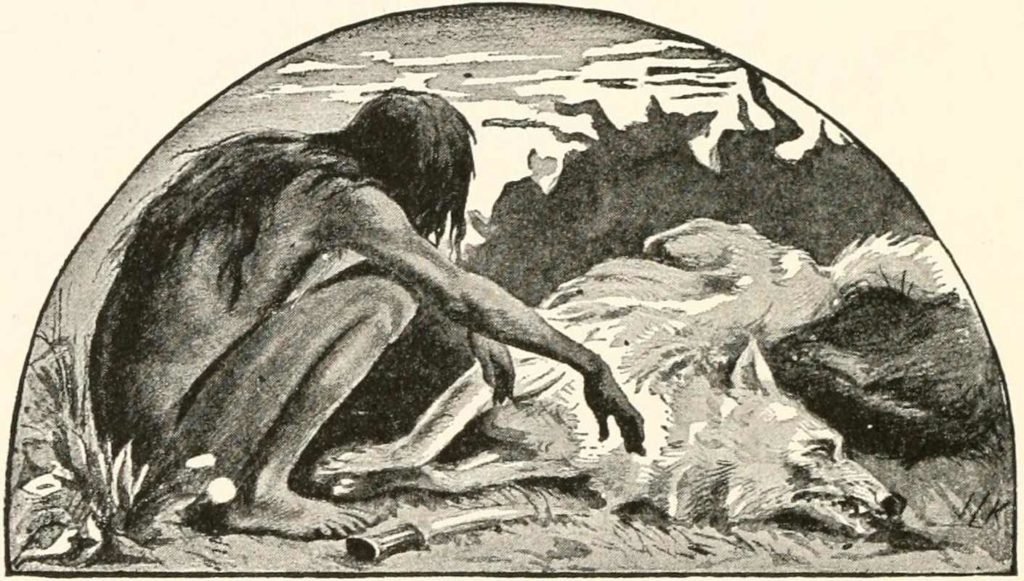
Prayers to a cruel and fickle ice god.
And while I was working on form, I also put more thought into motifs. This piece has a lot of rich material, maybe even too much. Though I love that there are so many fun ideas in there, sometimes it plays like one of those Beatles songs with too many good ideas but no development. This time around I went through the piece with a needle and thread, and wove my favorite motifs into the very fabric of the piece. In and out they come, appearing and disappearing again, becoming more recognizable with each appearance. Just as a chef might pour a bit of the boiling gnocchi water into the sauce to bind all the flavors together, my goal was to bind all the ingredients of this music together into something coherent (and tasty).
Like this motif, which appears everywhere:

Or this rhythmic motif:
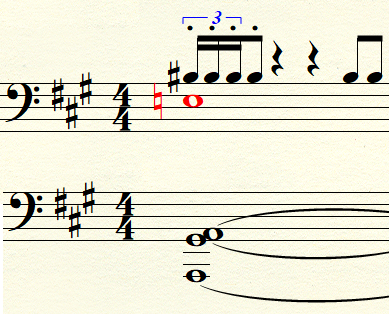
There was something else fundamental that needed retooling: instrumentation. Originally I chose three flutes and piano for this piece, because the flutes evoked the lonely, frozen tundra. But as I was writing, I didn’t pay enough attention to the limitations of the flute. I wasn’t writing in an idiosyncratic way, I was just cranking out music. The used a lot of low C’s on the flute because I liked the sound, but I knew the notes were ringing out stronger in my head than they would on a real instrument, where that low C is easily covered up and lost in the mist. I considered an alto flute, but decided a clarinet would give me a whole other palette to play with.
When one phases in a new instrument like this, one can’t just paste the flute part into a clarinet staff and call it done. The addition of the clarinet changed the whole character of the piece. While the flute is cold and isolated and graceful and metallic, the clarinet is like warm baking bread. It’s also intense, frenetic, a bit insane at times, with low earthy tones that can feel angry or foreboding or subdued. That new voice greatly expanded the range of the piece, so I was able to open the music up a bit and let it breathe.
All these forces combined into something much different than the piece I’ve been kicking around all these years. This version feels like a completed piece of art. It’s not just a sketchbook of ideas, it’s a story arc with real meaning. In other words it really does feel done. For real this time. Seriously.
This music is about suffering, and in a way the audience suffers a bit as they listen. It is not over quickly. But the music is also about hope, and the idea that suffering is a part of life, and doesn’t necessarily cancel out the good. There are joyful memories mixed in with the pain. There is a dream that soon the pain will end. Yes there is fear, yes there is chaos and anger. But the sun still rises at the end, even if the air all around is frigid.
My first piano sonata took me over a decade to complete. Then Jack showed up and POOF, it was done! Strange how that happens.
I always call this piece “Jack’s Sonata”, but half of the music actually predates Jack by some time. In fact, the last two movements are my earliest completed piano music. I was working on the first drafts all the way back in 2006, maybe earlier, when I was still living in the dorms at Cal Poly, a time when I knew I wanted to be a composer but had no idea how to actually write music. I remember so clearly the frustration of having music in my head, but lacking the skills to notate it. Hence, I started this music with the best intentions, but quickly became frustrated when I couldn’t finish it and tossed it in the ash heap. Luckily my ash heap is just a folder on my laptop, so the music was easily resurrected. By the time I picked it up again 10 years later, I was more properly equipped to complete the task.
So why does this music belong to Jack if it was begun long before he was born? Because Jack got me to finish it. I write such better music when I have something meaningful to write about, and there’s nothing more meaningful than the birth of my first child. The gaps I had left in the music over the years were suddenly filled in by the waves of emotion I felt as a new father. Usually I write slowly and methodically, but Jack’s presence in my life lit a fire under me and kicked off an avalanche of creative activity. Jack gave me so many new things to think about, new ways of looking at the world, new experiences. Holding a newborn brought on such a strange combination of intense love and intense uncertainty, and all of that worked its way into my music. So even though the music is older than Jack, in a certain way he owns it. I’m not sure I ever would have finished it if it wasn’t for him. His little face is imprinted on every note.
Paul Dab, my former piano teacher, also owns a piece of this music. When it comes down to it, I had fallen out of love with the piano, and Paul rekindled that fire. He made me excited about the instrument and showed me new ways to explore it. That excitement drove me to finally finish this sonata (including the composition of two brand new movements from scratch). Paul showed me how to think like a pianist again. I put my hands back on the instrument after a long hiatus, not just to tinker with chords but to play, play, play! He gave me the tools to improve my technique, both as a performer and composer, and he showed me how to write idiomatically for the piano, something that is often forgotten when writing music directly into the computer. This work would not exist in its current form without his guidance. Therefore, even though I always call it “Jack’s Sonata”, it is officially dedicated to Paul Dab.
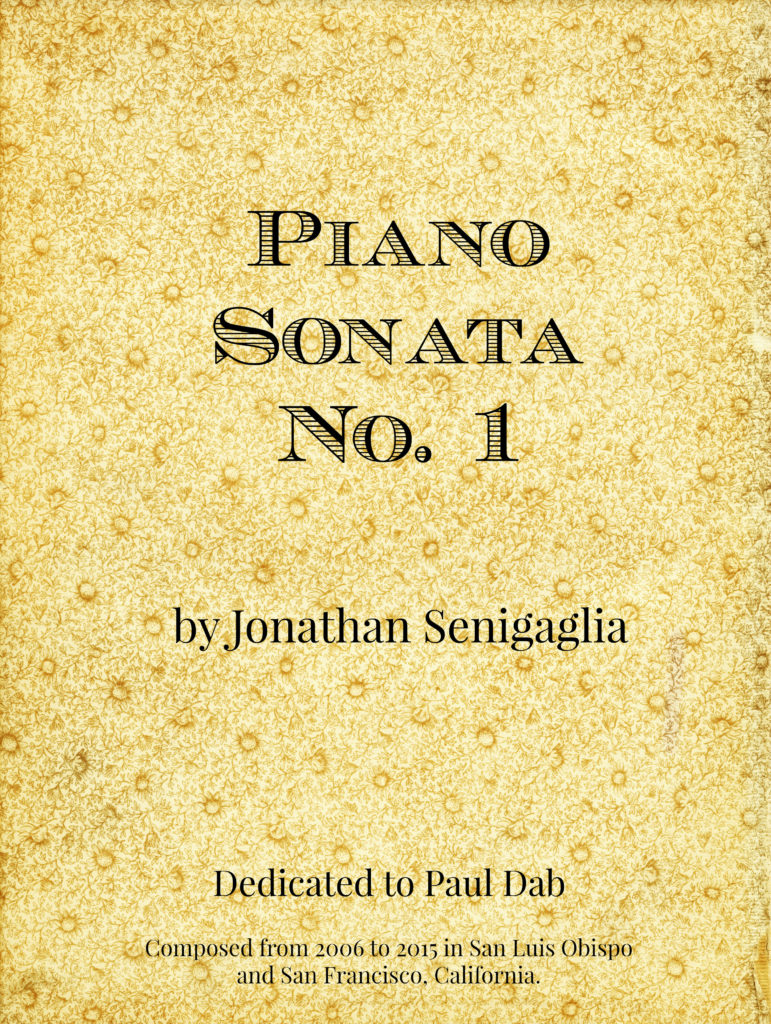
Movement 1: Allegro con brio
Here’s what the first movement sounds like (computer rendition):
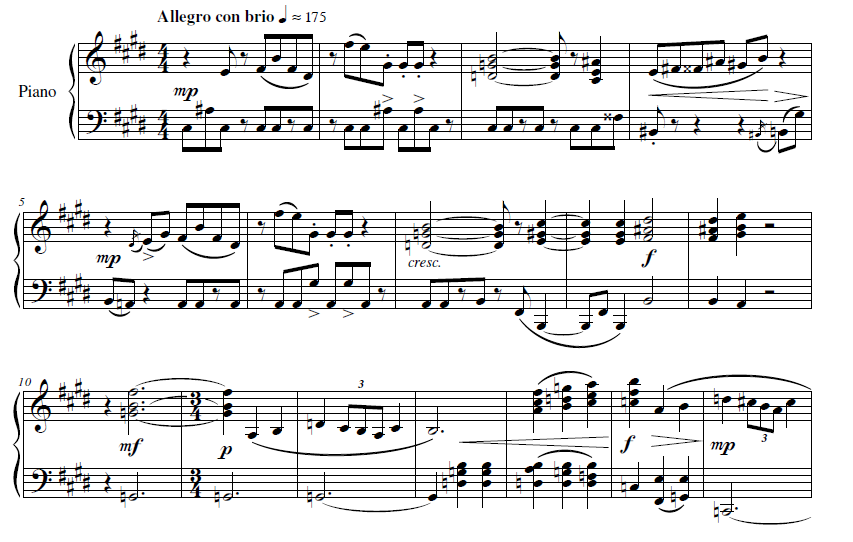
You might be thinking, “hmmm that sounds a little minor. I thought he said it was about his newborn son.” Well, yes and no. It was written right after he was born, but it’s not really ABOUT him. It’s really about me! It’s my musical reaction to some crazy-ass change happening in my life. It’s a burst of creative energy as my whole life gets flipped upside down. I think it’s fear of the unknown. It’s everything I felt when I held that precious, tiny, fragile, little nugget and pondered my place in the universe. This is an example of some music that just poured out. I had a lot of things to work out, and writing music is excellent therapy.
That being said, I still had to put a whole lot of thought into this movement. I spent hours and hours at the library hashing and rehashing ideas, experimenting and prototyping and testing ideas and staring blankly at the wall. Originally I had written an entirely different first movement way back in 2006. But when I picked this music back up in 2014, I realized that that whole thing had to go. There may have been some salvageable ideas buried in there, but I couldn’t help but see the whole thing as student work. I tossed it in the trash and started with a blank page. The music that came out of my brain belonged entirely to Jack.
This movement is highly structured, though it might not seem that way at times. Straight-forward, good old-fashioned sonata form. Ok, maybe not too old-fashioned. But really, it follows the same basic structure as the first movement of most Beethoven sonatas: Theme 1 in tonic, theme 2 in either dominant or (in this case) mediant, followed by an unstable gobblety-gook of the two themes all mixed around and intertwining, leading finally back to the first theme again in the tonic, and the lastly the second theme now transposed to the tonic. So though it may sound at times as if it contains a hundred different unconnected ideas, I assure you it is firmly rooted in classical forms.

For a first movement of a sonata, the music has got to be catchy, a bit flashy (but not decadent), and something the listener will want to hear again. For the first theme I got hooked into this angsty minor bluesy vibe that keeps falling into a mellow waltz. It can’t really make up its mind on what it wants to feel. The slightly slower second theme is cleaner, with a bass line reminiscent of a rock riff. I often find myself absent-mindedly humming this theme. It’s chipper, skippy, but never entirely major. Slices of it almost give off a pop vibe, though I made sure to end it on a sour note. These two themes are a microcosm of my psyche at the time.
Movement 2: Largo, but freely (“Jack’s Song”):
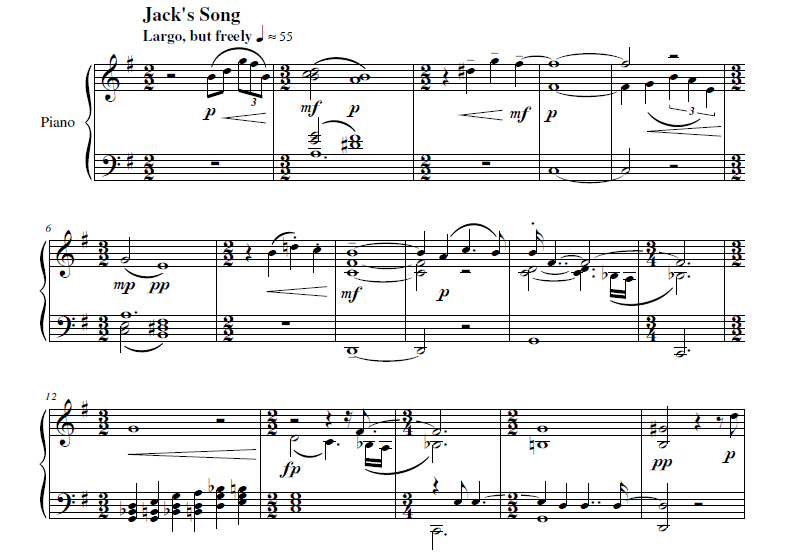
Here’s a computerized version:
And here’s a live performance from pianist Jun Cai, a student at the SF Conservatory (notice how much more flexible Jun is with the rhythm than the computerized version. There are infinite ways to interpret a piece of music):
This second movement truly does belong to Jack. As this music began to take shape, I was thinking a lot about what it means to be a father, which means my child shaped it. This music is a projection from my mind at the time, a reflection of my emotions and questions, my fear and love. The music fades in and out of coherency, at times directionless, until it finally lands on solid ground. It’s asking a question, and just as the answer comes within reach, it slips away again. This movement is tough to pin down, difficult to categorize. The music is searching, searching… It emerges slowly, pops in and out of view, like a distant ship in the mist. Sometimes it’s a love song, sometimes a lament, sometimes a hopeful look toward the future, and sometimes a lonely figure grasping for something in the dark.
I wrote a good chunk of this music in libraries, specifically the Richmond Library in SF and the Shaw Library in Washington DC. The whole ambiance of the library worked its way into this music. Libraries are bustling with activity: people walking around, searching, questioning, writing, working; children running around and older folks quietly reading the newspaper. Yet it’s also an environment where quiet reflection is of paramount importance. It’s a perfect mix of energy and silence, and I find it a very inspiring atmosphere to write music. This piece also feels to me like it is a mix of quiet and activity. I think this movement is one of my favorite things I’ve ever written… though when I first wrote about this music in my composition journal, I clearly wasn’t sure what I thought about it. (See below for the composition journal).
Speaking of my composition journal, reading the entries for this piece reminded me of how crucial sketching is when developing a new piece. I started this movement by jotting down various ideas without editing, then seeing where those ideas led. This was a period of time when the music was coming out rather quickly, and I think sketching had a lot do with that. When I’m feeling something and just need to write music, it is so important that I don’t edit myself, but instead just get everything out. Sometimes I don’t have the time or wherewithal to plan an entire piece in advance. Sometimes I just have to throw paint on the canvas then step back and figure out what shapes I created.
For example, this improv led to an important section in the piece:
And this one became the main theme (listen for Baby Jack in the background):
Movement 3: Minuet and Trio – Andante con moto
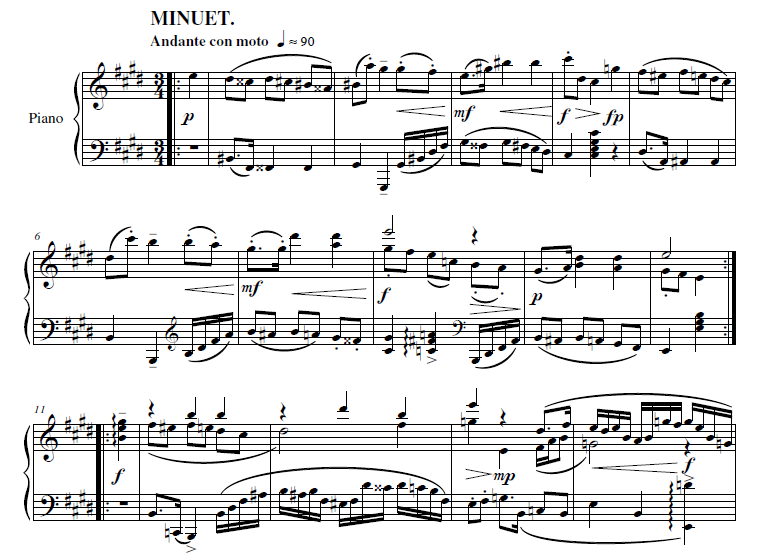
Here’ s what it sounds like, computerized:
This movement may very well be the earliest completed piano piece I ever wrote. I’m not sure exactly when I started it, because it predates my habit of keeping a journal. But I think I have a memory of working on it in 2004. I can’t be sure, but it was definitely in a semi-complete form in 2006.
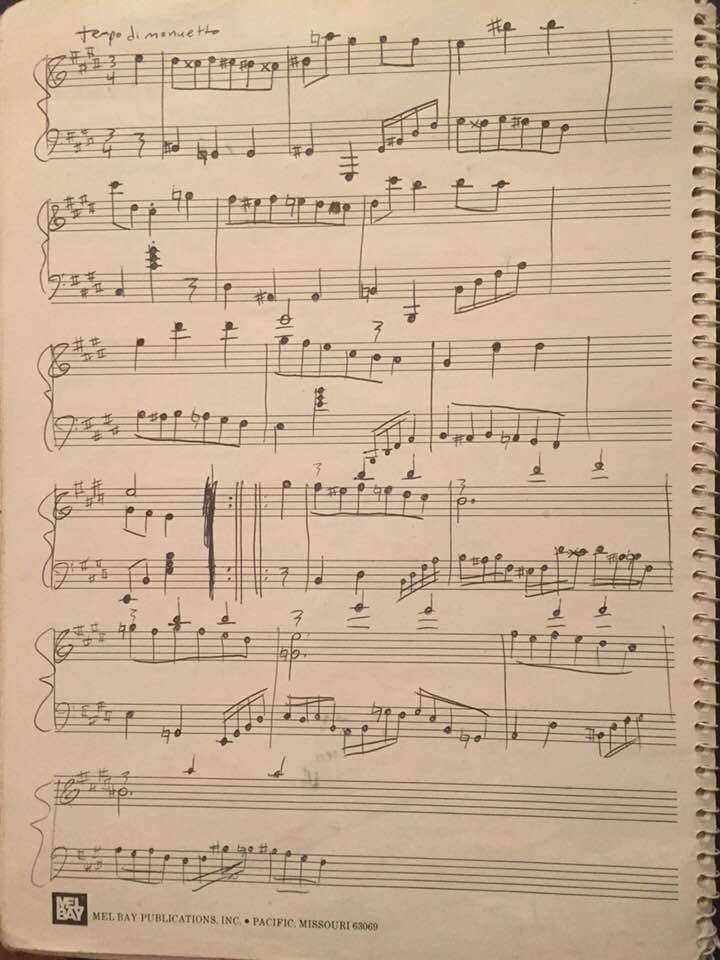
When I revisited this music in 2014, I mainly focused on adding some subtle touches to it (integrating some of the motifs into the fabric of the piece, rethinking dynamics, making it more playable). I originally picked it up again because I was looking for a piece I had written that I might actually be able to play well. This is why I give Paul Dab a lot of credit for inspiring this whole sonata. Once I started tinkering with this old nugget again, I realized I was ready to complete the entire sonata. This is the movement that jump-started it, even though it’s the simplest and more straight-forward movement of the four.
This movement is in a truly classical form: minuet and trio. A short set of Baroque dances, usually inserted into a sonata or symphony, allowed the composer to construct a stately, graceful, low-key moment of rest before the rush of the final movement. Beethoven, Mozart, Haydn and all those dudes used it many times. I really didn’t add much to the structure or push the envelope with this one. It is truly a classical piece, fairly conservative. The form looks like this:
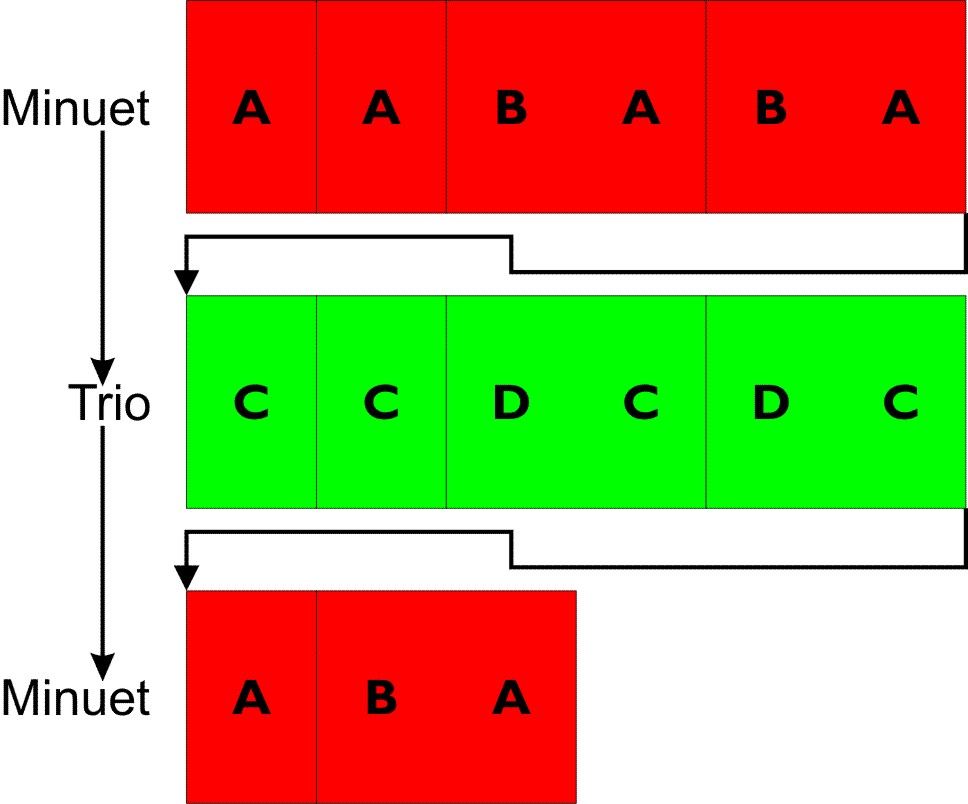
Conservative does not mean bad though. This entire sonata is full of traditional harmonies and forms, yet it still expresses what I wanted to express in that moment. This minuet is more traditional than I would probably write today, but when I started it in 2006 and finished it in 2014, that felt right in those moments. Sometimes going back to basics can unlock all sorts of new ideas.
This piece has a slight drunken quality to it, almost like the music is slurring its words. It gets a bit heated, but in a restrained way. The Trio is a bit angelic, very light, with just a flash here and there of tension. Overall, I don’t want to read too much into this one. Not all music is strictly progammatic music. When it comes down to it, this is a simple minuet and trio. I think I was playing more with form here than with emotion. This little dance is really just a calm interlude before the energetic and weighty final movement.
The minuet is nice to play though:
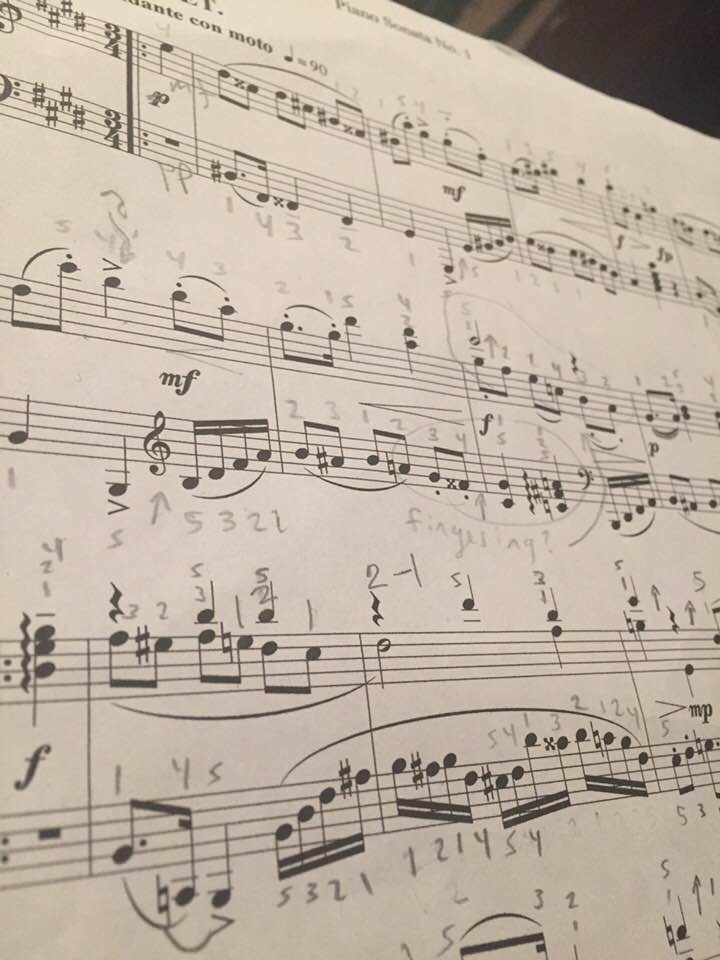
Movement 4: Rondo – Allegro Molto
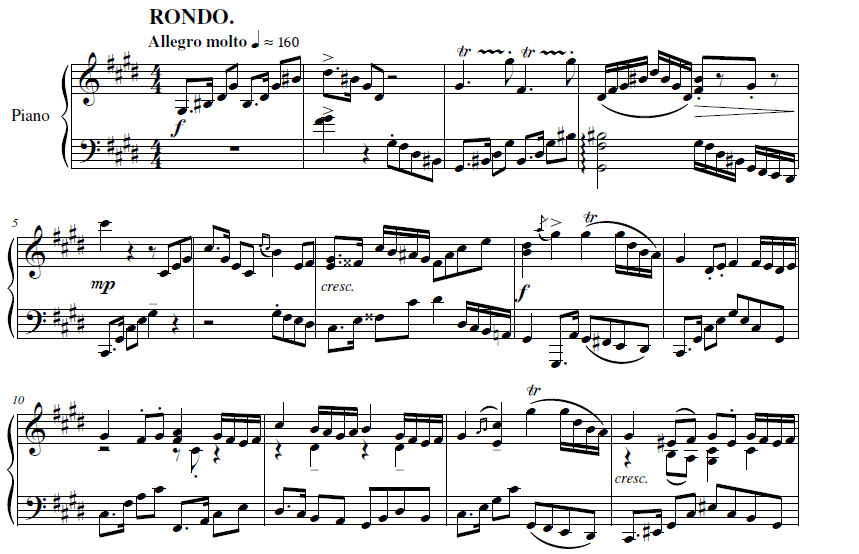
Here’s what it sounds like (computerized):
This piece is a classic. I have a vague memory of starting it way back in 2003, but I only wrote a few measures before I couldn’t find my way forward. That was when writing a simple chord progression was an uphill battle for me, so this piece was born from pure gut and intuition. Those tools will get you only so far, before technical skill is required to turn a fun little building block into an actual piece. Though I could vaguely hear this music in my head (or at least feel the emotional direction I wanted to take it in), I couldn’t figure out which chords I should use to actually express those vibes. In other words, I couldn’t compose my way out of a paper bag. This tiny nugget was all I had, so I put the piece down for a couple years and focused on learning.
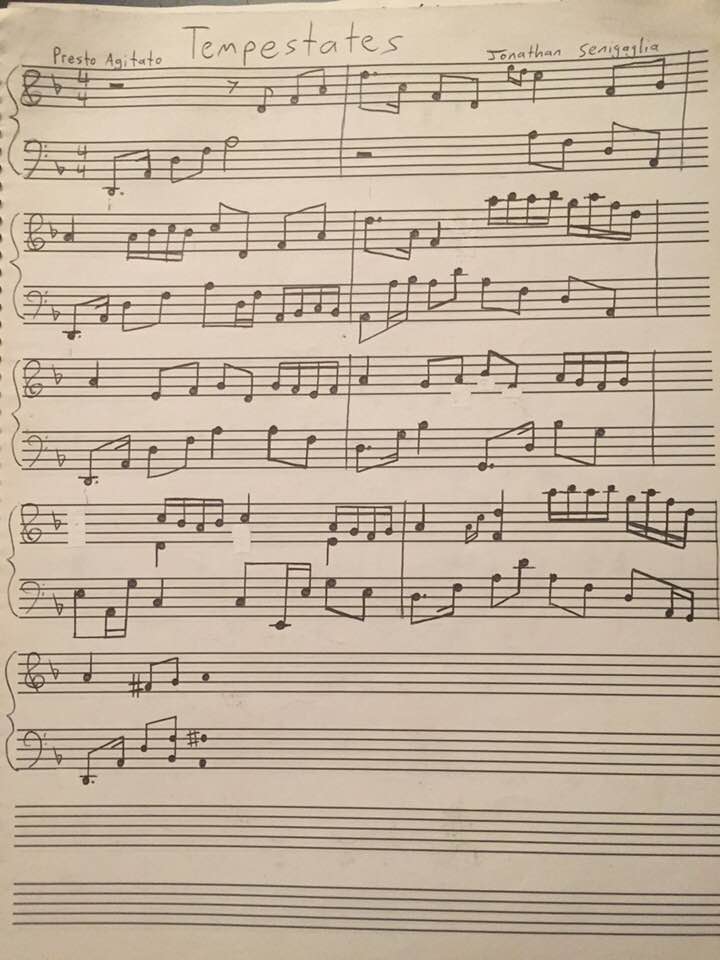
I used to call this music “Tempestates”, I think because I wanted to write a series of pieces about Greek gods or something along those lines. Instead I forgot about this music until 2006, when I was about to begin work on a final project for one of my composition classes. My professor, Meredith Brammeier (who is more responsible for my love of classical theory than anyone else on Earth) suggested that I write a medium-length piece with a clearly discernible form. After pondering my options for a bit, I rediscovered this musical fragment and thought it might make a decent rondo.
Rondo form is another classical form, usually appearing at the end of sonatas and symphonies. It goes something like ABACA, otherwise known as the deli sandwich of classical music.

This piece is very classical-sounding, or early-Romantic to be more precise. Essentially it’s in the style of Beethoven, since that’s who I was obsessed with (still am) when I was writing most of this. Back during that time, when I was still working at the Cal Poly library, I would push the cart of books around the different floors, listening to the entire catalog of Beethoven sonatas on my iPod over and over and over again, until I could hum every movement of every sonata. This Beethoven binge gave me a very strong appreciation of classical form and harmony, but also how to stretch those forms to express something deeper, how to turn form into art. Form is absolutely crucial in classical music, but it can’t be everything.
This movement probably leans more toward form for the sake of form than it does toward pure expression. As a young composer, I think I had to become proficient at form before I could wrap my head around pure expression. But built into this very structured piece is a nice dose of angst, nervous energy, and questioning, the same turbulence that guided the first two movements.
The C section is a soft interlude that plays with a couple motifs we heard earlier in the sonata. But this was not the original C section. I composed the new one mostly over Christmas break 2014 at Erica’s parents’ house in San Diego, on quiet evenings next to the giant Christmas tree, while Erica chatted quietly with her parents in the next room. The old one from 2006 was short, jolly, and fairly tight (not a lot of room to breathe). When I picked this piece up again in 2014, I probably could have expanded that old C section and gave it a bit more flair, but I decided to scrap it and start over. I wanted to write something restrained, quiet, and a bit jazzy, exactly what I wanted to listen to on those chilly winter evenings when the house was quiet.
Here’s the old C section on its own:
It’s got a bit of pep to it, but it doesn’t quite tickle me. I might salvage that one day, but for now it’s on the ash heap with so many other forgotten musical fragments.
Just for fun, here’s a video game version I made a while back:
So that’s about it for my first real-life piano sonata. Is it a perfect piece of music? Absolutely not. The final movement is too tightly wound for my taste. Were I to work on it now, I would stretch it out and let some of the ideas (and the listener) breathe a bit. I do love the first two movements, as they match my more current writing style. But as it stands they don’t exactly fit with the final two movements. This is a lesson I learned while listening to Ozma’s “Double Donkey Disk”: two very different EPs jammed together don’t exactly create an “album”. The two halves of this when taken as a whole do not feel organically written; but instead they resemble a slightly awkward arranged marriage. Which makes sense, considering the two halves were written a decade apart from each other. They are, however, united in one important way: I finished them all at the same time, motivated by the changes fatherhood brought to my life. So though the two halves aren’t necessarily united thematically, stylistically, or even artistically, they are forever united in my memories, and therefore they will remain together for eternity.
Below you will find my composition journal entries for this sonata:
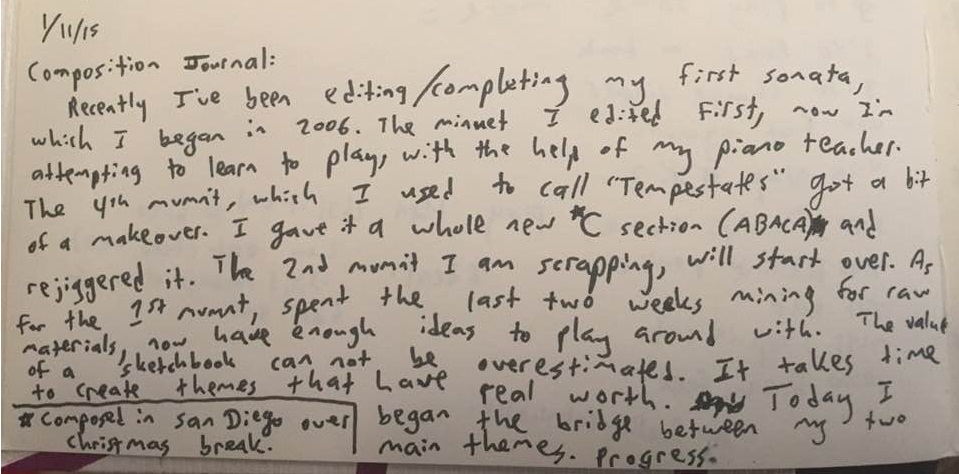

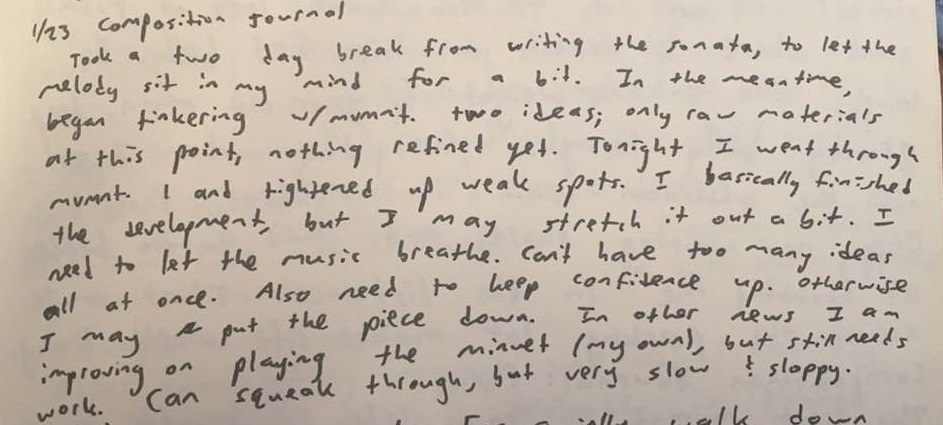
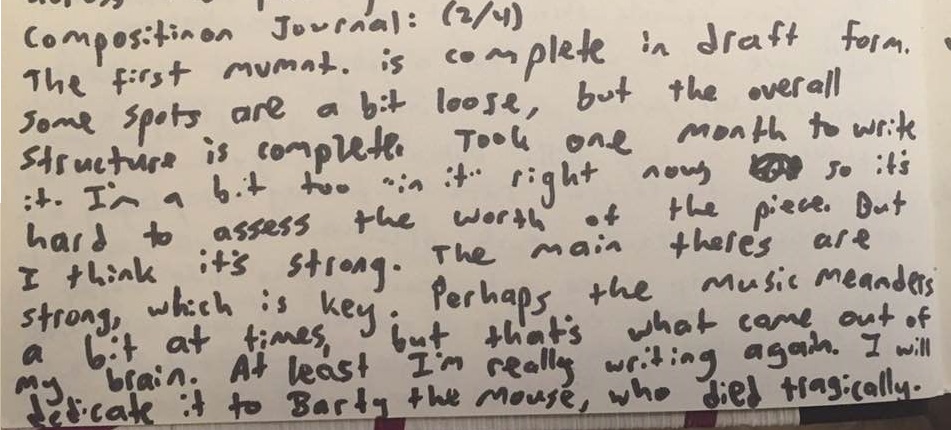
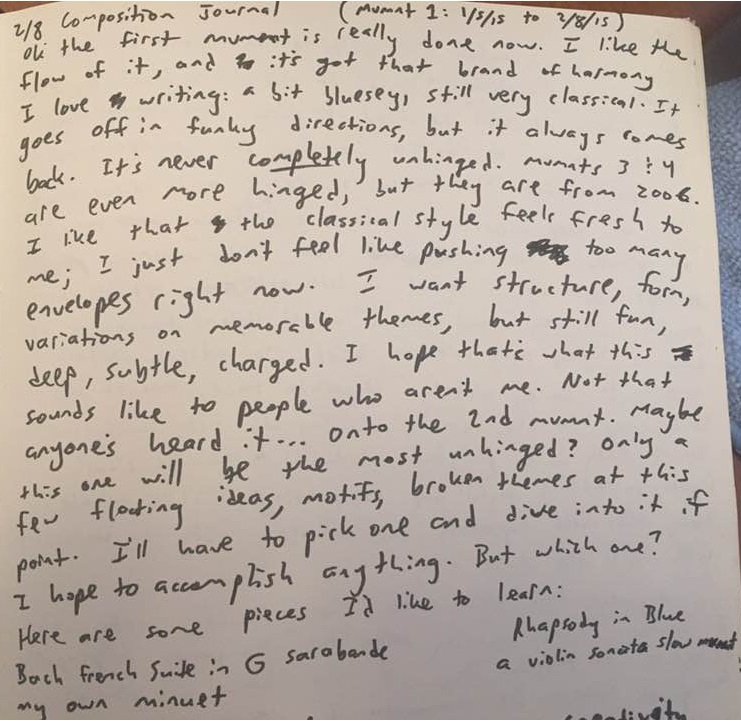
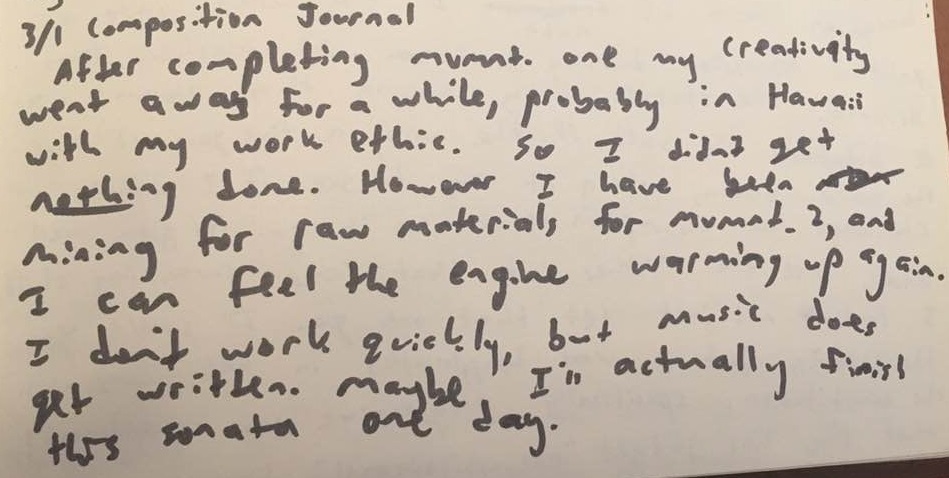
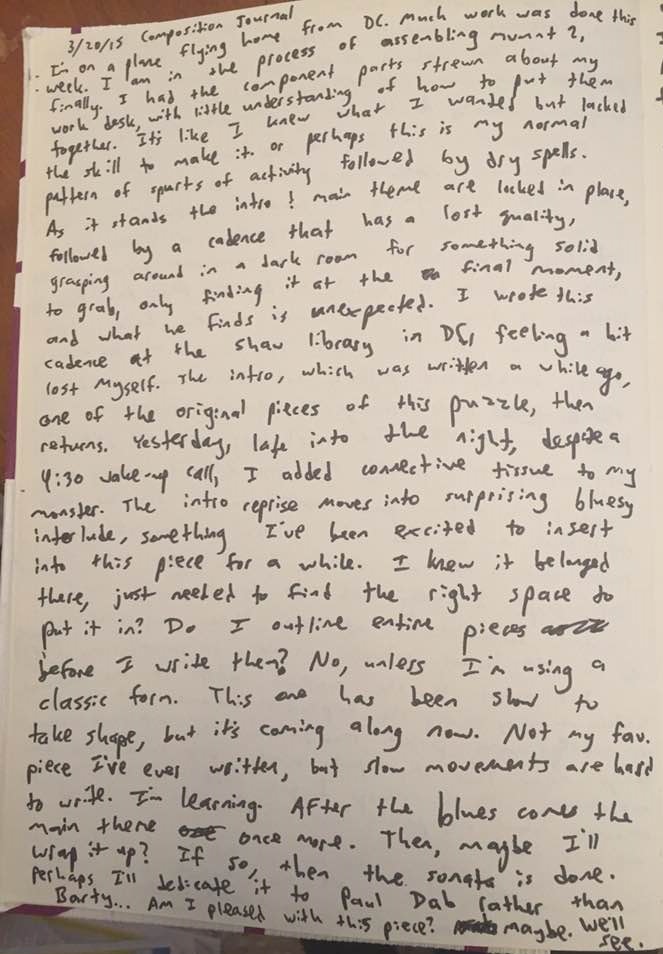
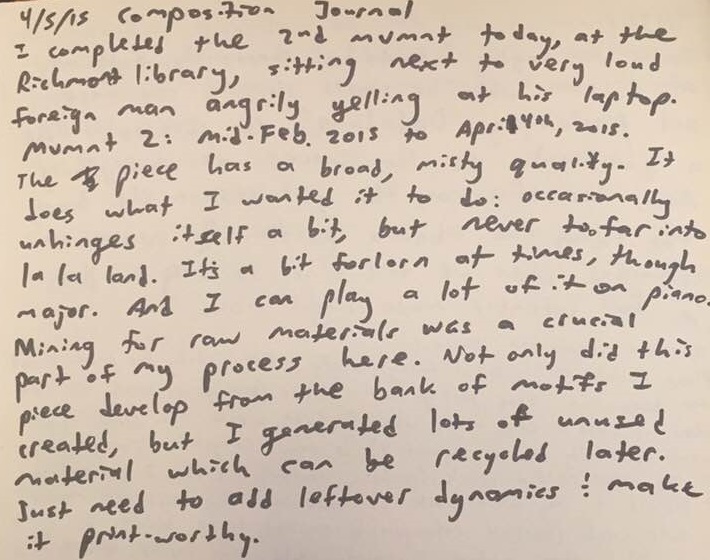
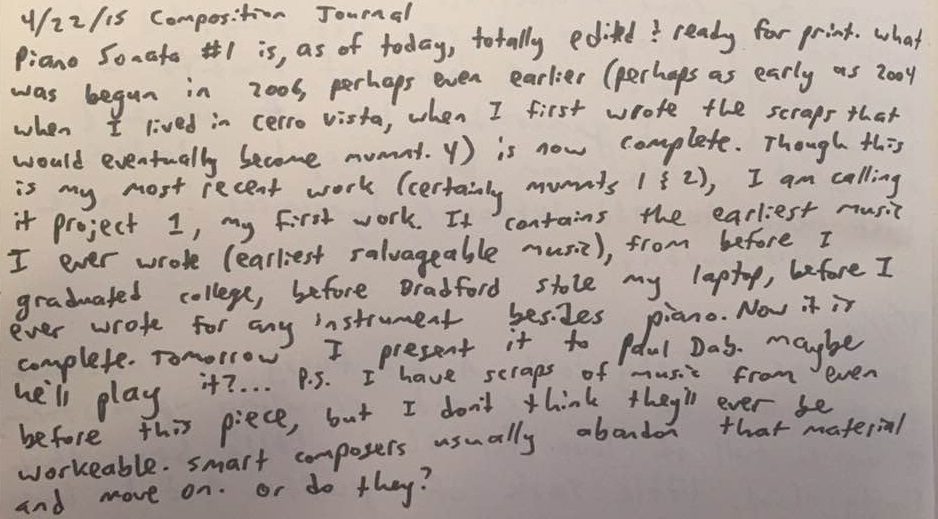
One chilly December evening in 2012, while I was enjoying a beer at the Riptide bar in San Francisco, listening to the soft tones of an open mic guitarist, I encountered a man who told me about a new songwriting club that had just started in the city. He said anyone can join, you just gotta write songs. Little did I realize that this encounter would spark one of the most prolific stretches of songwriting in my life.
This bar, a crucial landmark of the far west, shines like a proud beacon in the foggy, grey, windswept outer reaches of the Sunset district. It’s the perfect place to seek shelter from the ocean breeze and enjoy one of the chillest open mics in the universe. They even have a piano. The Riptide has since burned down and been rebuilt from the ashes, like a f*cking phoenix, and it’s still just as grand as ever! On the night I first heard about the Songwriting Club, I was alone at the bar, sipping a beer and reflecting on life, asking the universe for inspiration. When I learned a bit more about this new creative endeavor, something inside me clicked.

Here’s the gist: write one new song a week, based on a title assigned by the creator of the club (a local musician and concert promoter named KC Turner). Each week a new title and new song. Only rule: don’t miss the deadline. It wasn’t a competition, just a personal challenge. By the end of the week, a video of the new song must be posted on the Songwriting Club’s Facebook page for all the world to see. The first title was “Find Your Own Railroad”. Ready, set, go.
I’m not sure why this particular challenge burrowed so deeply into my head, but for whatever reason I went home that evening with an agenda: I had to write that song by the end of the week. I started thinking about that title and what it could mean, and a story began to take shape in my brain. An alcoholic father encounters his alcoholic son at a saloon after many years apart. The son realizes he has become just like his father, and pleads with the old man to come away with him over the hills. Together they can reform their lives, put down the bottle for good, rebuild their tattered relationship.
The jaded old man tells his son that that’s an impossible dream, wishful thinking. He’s going to do what he’s always done – drink until he passes out in the street – and his son had better go find his own destiny: “Find your own railroad, don’t get off until the track runs out. And if you ever come back to find your old man, you better look six feet beneath the ground.”
Here is the first performance of the song at the Hotel Utah Saloon open mic, with Erica singing harmony:
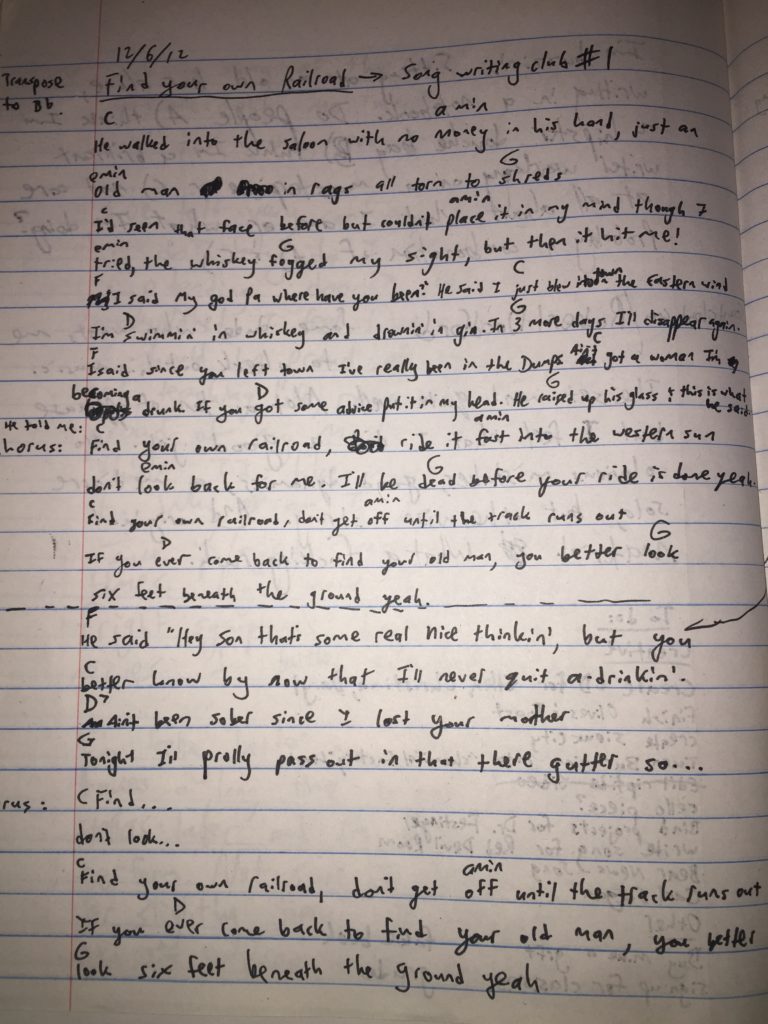
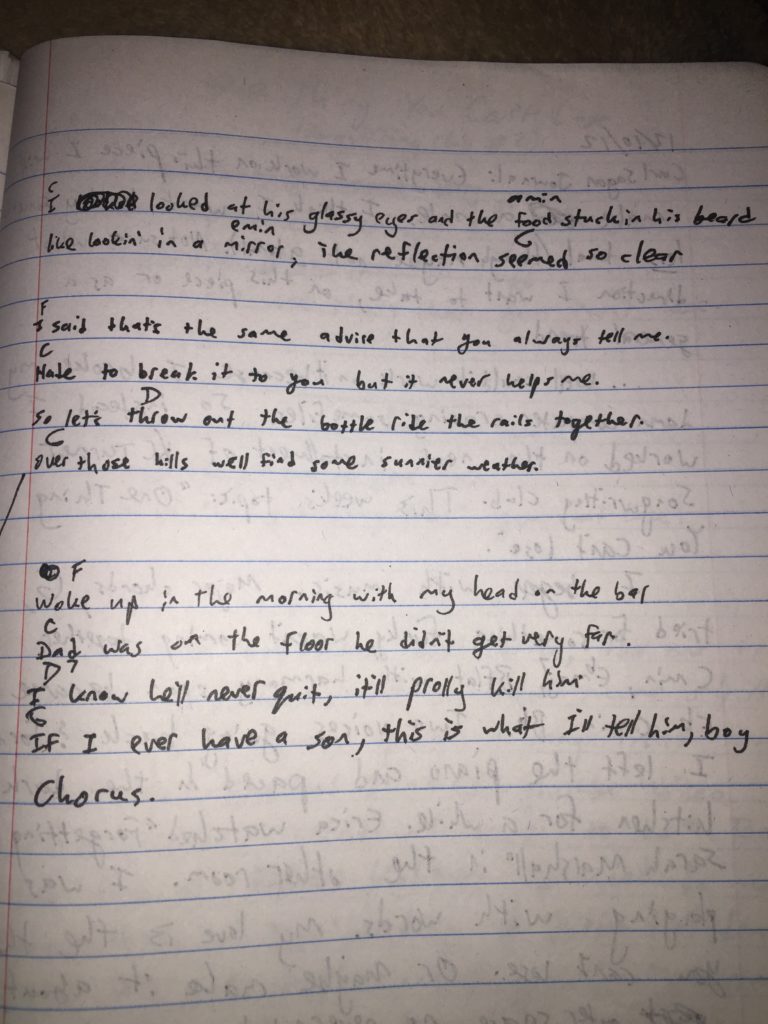
At the end of that first week, a TON of local songwriters had posted new work on the page, each with the same title. What a unique opportunity to listen to so many composers tackle the same theme. Everyone’s work was special in their own way. Some were blues, some country, some spoken-word, some undefinable. I left encouraging comments on various performers’ posts, and they did the same for me. I wanted to stay a respected part of this community for as long as possible, but the only way to keep that going was to write write write!
The next week’s title was “One Thing You Can’t Lose”. My first thought was to do a love song, something like “my love is the one thing you can’t lose”. I tinkered with a bluesy vibe, but didn’t love it. This is where a challenge like this can fall apart. You lose your confidence and that’s it, that’s the end. But this also happened to be the week of my ten year anniversary with my muse and life partner, Erica. I think her muse powers were off the charts that week, because this strange little love song just seemed to emerge from nowhere.
The song is about love aaaand also about the Titanic. Love is the ocean, and there’s no keeping it out. We sink into the black, deeper, deeper, into oblivion. We let it swallow us. We burn with a red heat that even the empty nothingness of the ocean depths can’t extinguish.
That song is called “Here Comes the Flood”. The lyrics really captured how I was feeling that month. It was such a mixture of dark and chilling with excited for life and full of love. In the previous months I had had a major falling out with an old friend and had not yet recovered from that sad episode. Yet celebrating a decade with the woman I love, and coming up on our first New Year’s as a married couple, I had much to be grateful for. I was swept up in love, but also questioning myself, my life, my purpose. Luckily I was able to harness some of this energy into a creative outlet.
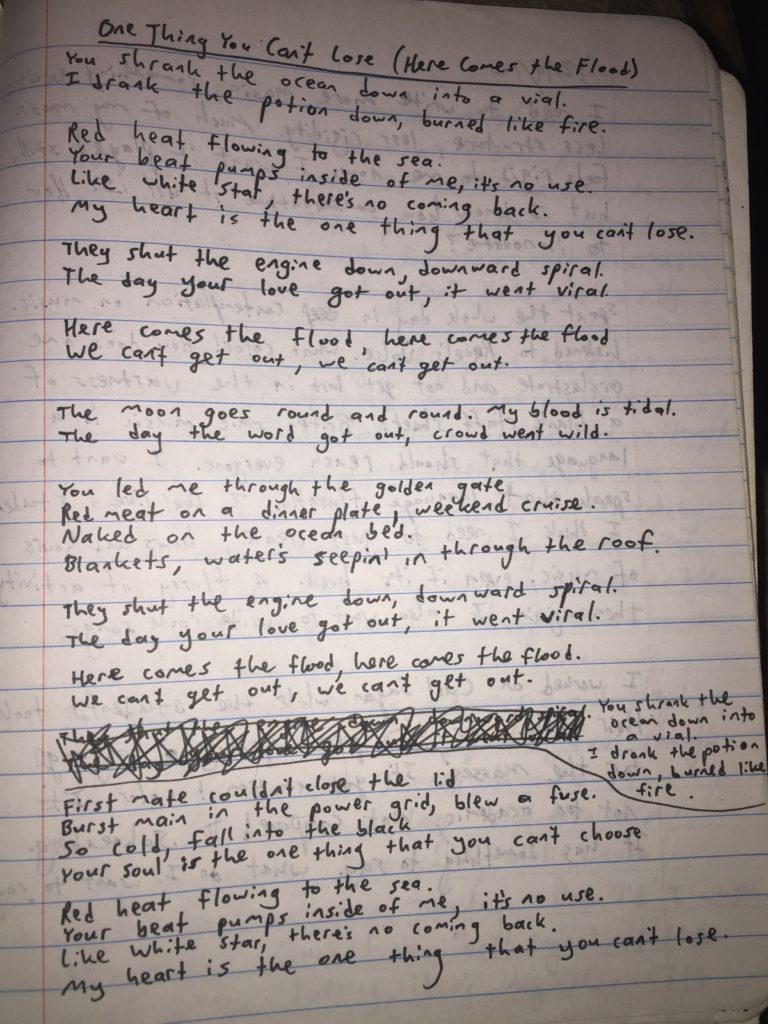
I am thoroughly sold on the Songwriting Club method of art creation, especially for any artist struggling to find inspiration. Adding boundaries and restrictions can be a surprisingly effective way to force an artistic brain to create. When our options are limitless, sometimes our brain will languish in indecision and self-criticism. No idea is profound enough to satisfy the mind. Should I write a love song or a techno song or a classical piece? How can I say something that’s never been said (impossible)? Where do I even begin when I have no idea what the final product should look like? These questions equal paralysis for the artist, who will probably just walk away from his pile of half-finished work and go watch Game of Thrones, wallowing in self-pity, crying out for a bolt of inspiration.
That bolt rarely comes. The reality of songwriting is the reality of all things of quality: they take time, hard work, and patience to do properly. If an artist gets trapped in this negative feedback loop (“I suck at music, so I won’t bother finishing anything. Because I can’t finish anything, I suck at music”), the artist does not progress. Add a boundary or two, and suddenly the artist can eliminate many of those questions that dog him when he wishes to begin a new project, and focus all of his creative abilities on solving a much more narrow artistic puzzle. If the musician knows he has six days to write a song based on a title he didn’t choose, he can get to work without asking if what he is doing is “avant-garde” enough, or what genre his music falls under. Just shut up and write. And if this week’s project isn’t perfect, who cares! You finished something. Now do another.
The next week we had to travel to San Diego to visit Erica’s parents during Christmas. Time for a road trip! Would we be able to continue our song writing streak? We would have to write this entry while on the road, with nothing but my trusty melodica to assist us. Would it be possible? When faced with a creative challenge (and a deadline), the answer I’ve always found is just sit down and work at it. Brainstorm and create drafts and play stuff over and over until you isolate something of quality, then exploit that little nugget for everything it’s worth. Just don’t give up. Harness the anxiety that comes with a deadline, and turn it into creative energy. We prepared to set out on the road.
It was at this moment that the songwriting gods blessed us with good fortune. This week’s title was going to be “Rhythm of the Road”. Forced to write a song about the road whilst on the road… is there anything better than that scenario? The sounds of the road weaved themselves into the fabric of the song. It was inescapable: this song would completely embody the spirit of the title, no matter what the final product sounded like. Whatever we created we would be true to the theme!
It also helped that I got to tap into the mystical power of the melodica. This particular melodica was very special to me, because I had purchased it in Venice, while on my honeymoon four months earlier. To this day, I really don’t feel comfortable playing this song on any instrument except the melodica.
Driving from San Francisco to San Diego gave us lots of time try different drafts, practice harmony, and finesse the song until we were in love with it. The final version is one my favorite things I’ve ever created, though to be honest I really can’t take much credit for this song. Erica created the melody and wrote most of the lyrics. It’s a song about this time we found ourselves drinking and telling stories at a sleezy little campground in Cody, Wyoming, far far from home, lost in a never-ending road trip across the vastness of the American West. This song was really Erica’s baby. I contributed the chorus and basically just sewed the nuggets she had already created into a coherent piece. This is truly a song written by Adventure Cat.
Now we were on a roll. Three weeks, three songs. We were flying high and ready for anything! The next title was “Mailbox Blues”. This one needed something new: Evan. We invited our trustworthy travel companion and fellow Adventure Cat to help us compose this week’s song. We sat down in his apartment and started cranking out ideas. The ideas flowed together into this little gem:
I don’t know who created which part. I don’t care. This song makes me happy, and very nostalgic. I also love Evan’s little solo in the video. We wrote the whole thing in one night. What a fun time that was.
The next week I got robbed. On a cold, clear night right before New Year’s, somebody smashed my car window and grabbed the first thing he saw. I didn’t have much of value in my car, only my melodica from Venice, which the thief dutifully stole. When he realized it was just a cheap, plastic instrument, I imagine he left it on a bus stop bench and ran off to find a more profitable mark. I never found her, but the melodica’s magic lives on in my heart, and in the songs she helped usher into the world.
It was the last memorable event of 2012, a rough way to end. That week’s title was “Last Day of the Year.” I condensed all of my sadness and fear and bewilderment into a little seed, and let it blossom into a song:
This song I wrote alone. I wrote it quickly. It poured out.
We had celebrated New Year’s Eve at a party full of people we did not know, at an enormous mansion deep in the Santa Cruz Mountains. Winding roads, shots of tequila, strange faces, the brisk mountain air, the smell of the ocean in the forest… all of it found it’s way into this piece. I wanted time to freeze, for the world to stop. I felt like I was slowly sinking into the Earth.
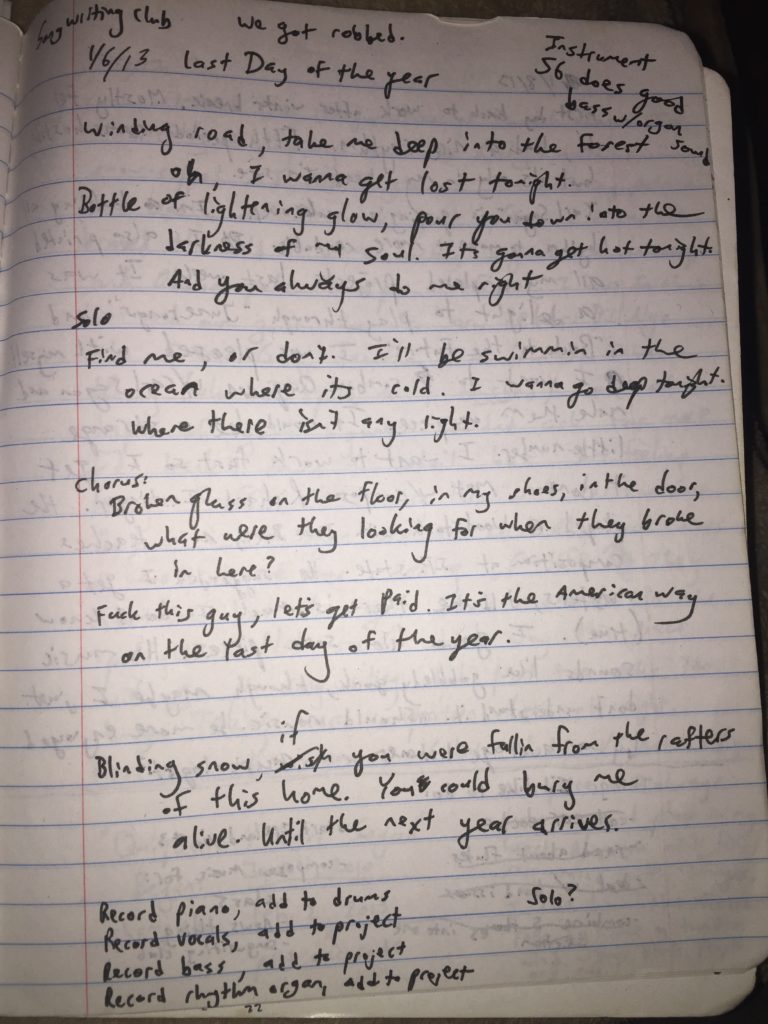
Though I did enjoy trying my hand at low-tech sound engineering, “Last Day of the Year” ended up with a lot of pops and clipping. I wanted to experiment with recording more layers, but one week was no longer enough time, especially once I went back to work. I wanted to really do something fancy for the next piece. So when I learned the next title, I relaxed my one week deadline and took my time with it.
The next title was “Tiny Wings”. Actually, as I write this, I’m not entirely sure that was a title in the songwriting challenge. I might have made it up… Either way it took me about three months to put this together, chipping away slowly night by night:
I was thinking about my mom and how she must view me, what it must be like to see your child grow into an adult before your eyes. I didn’t have a child at this time, so I couldn’t truly understand it, not yet, but this was my attempt at it. Now that I’m a parent myself, I understand it so much better. I think writing this helped me wrap my head around parenting for the first time in my life.
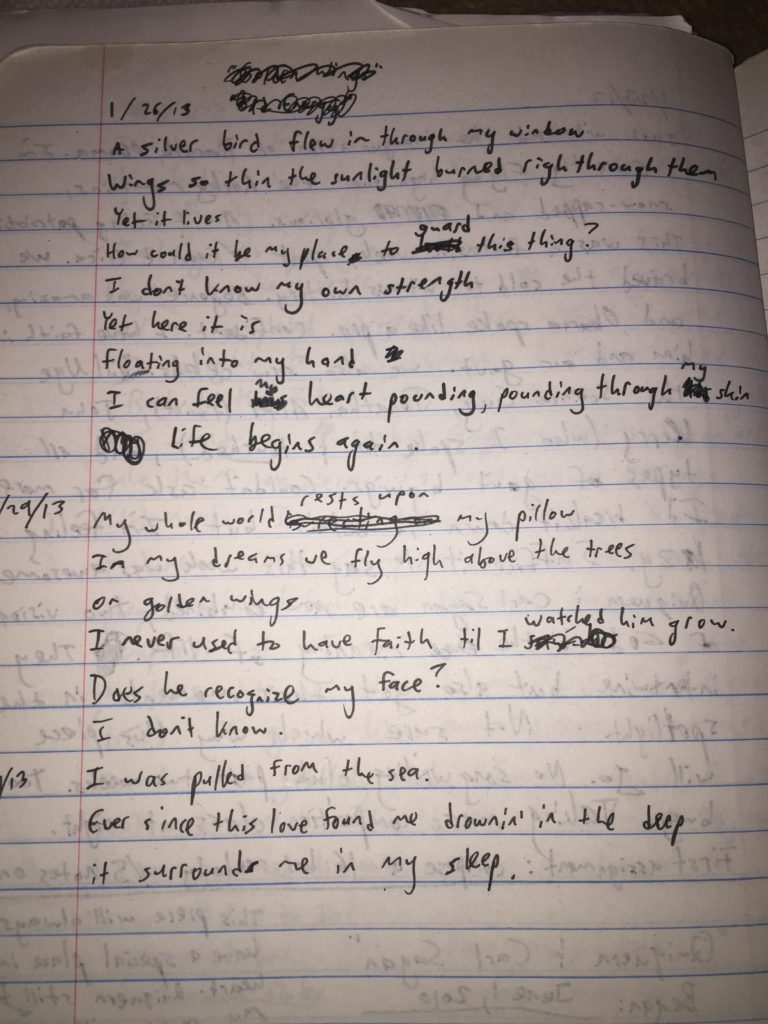
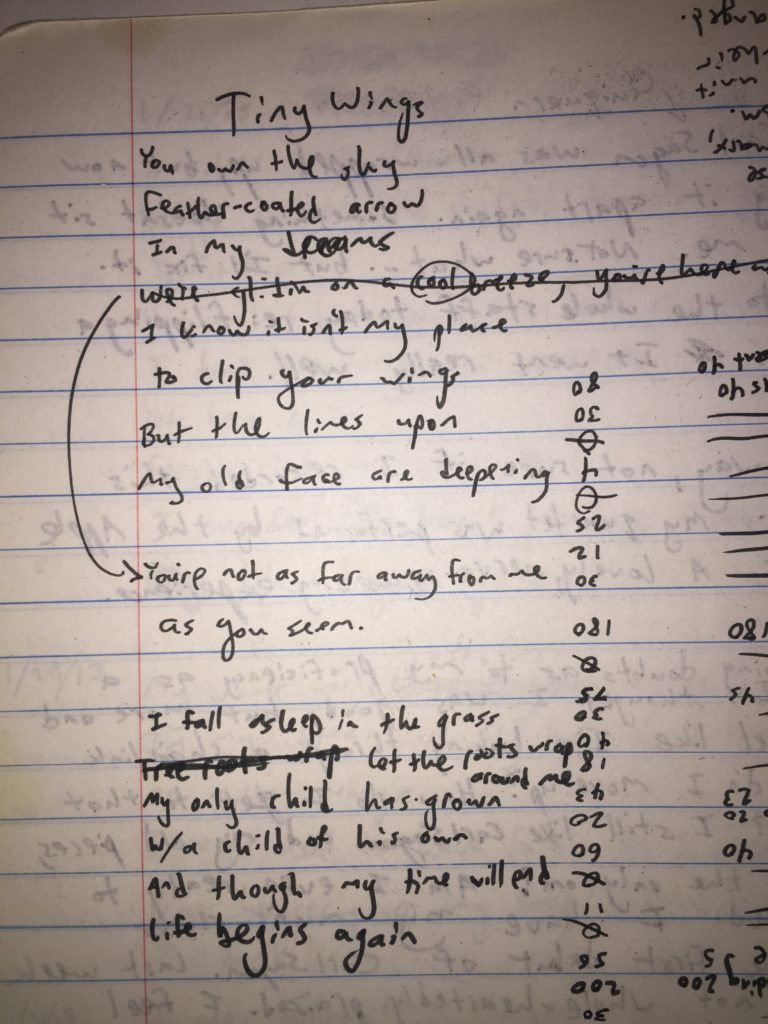
As far as sound engineering goes, I really didn’t know what I was doing. Just a lot of trial and error. The whole thing was made with a Casio keyboard and Finale notation software. This was a HUGE learning experience.
By this point I had missed a bunch of weeks, so I had a lot of titles I could choose from for the next song. One that stood out to me was “Somebody’s Lie”. I decided to make it “Everybody’s Lie”. This is probably the most nihilistic piece I’ve ever written, but I don’t think it takes itself too seriously. In fact, the whole point of it is how humanity takes itself far too seriously and deserves a bit of mockery for that. In that vein, I created a music video to go with it:
And yes I understand the irony (or perhaps hypocrisy) of an artist spending hours and days crafting a meaningful art piece about how nothing really matters. But I’m only human… The beat is by David Neawedde, the guitar licks are Evan Owen. Everything else is Cassio keyboard.
I wrote some other rock songs during this period, but only one more really counts as Songwriting Club material. I went to the site one final time and selected the title “10,000 Hours”:
This song finally allowed me to express some of the anger I had been holding onto after that falling out months and months earlier. Sometimes it takes awhile for these things to work their way to the surface, but when they do they always emerge as a kind of muse. This process of creation through pain allows me to heal. After writing this, I really did feel better about the whole situation.
I also call this song the hypocrite song, because the speaker could be speaking from my point of view, or my ex-friend’s point of view. Since we both acted so terribly during the falling out, neither is blameless. I am guilty of every crime I accuse him for. And yes, that’s Evan on the guitar again, killin’ it.
After this song I fell away from the Songwriting Club for good. I still wrote new stuff when the feeling took me, but never at the same speed as during those late weeks of 2012. The artistic stars aligned for me during that brief period, everything worked. The new material not only allowed me to flex my creative abilities to their limits, but also to bond with my loved ones through the creation of art. And that is a rare and cherished thing.
By the way, if you want to work on your song-writing chops, find yourself a songwriting club. Or just grab a title out of the newspaper, or a billboard, or the babblings of a toddler. It’s your songwriting club, so do it however you like! The only rule is you have to finish whatever you start. You must not put the project down until it is done. And if you run out of time or patience, and you are forced to call it finished even though it isn’t a brilliant, earth-shattering masterpiece, good. You still finished a piece! Well done, seriously. You are creating art. Now do another one, and another. Some will be winners, some won’t quite ever feel right no matter how many times you tinker with it. But you are practicing, honing your craft. Every finished work gives you experience points. So good luck, and happy writing!
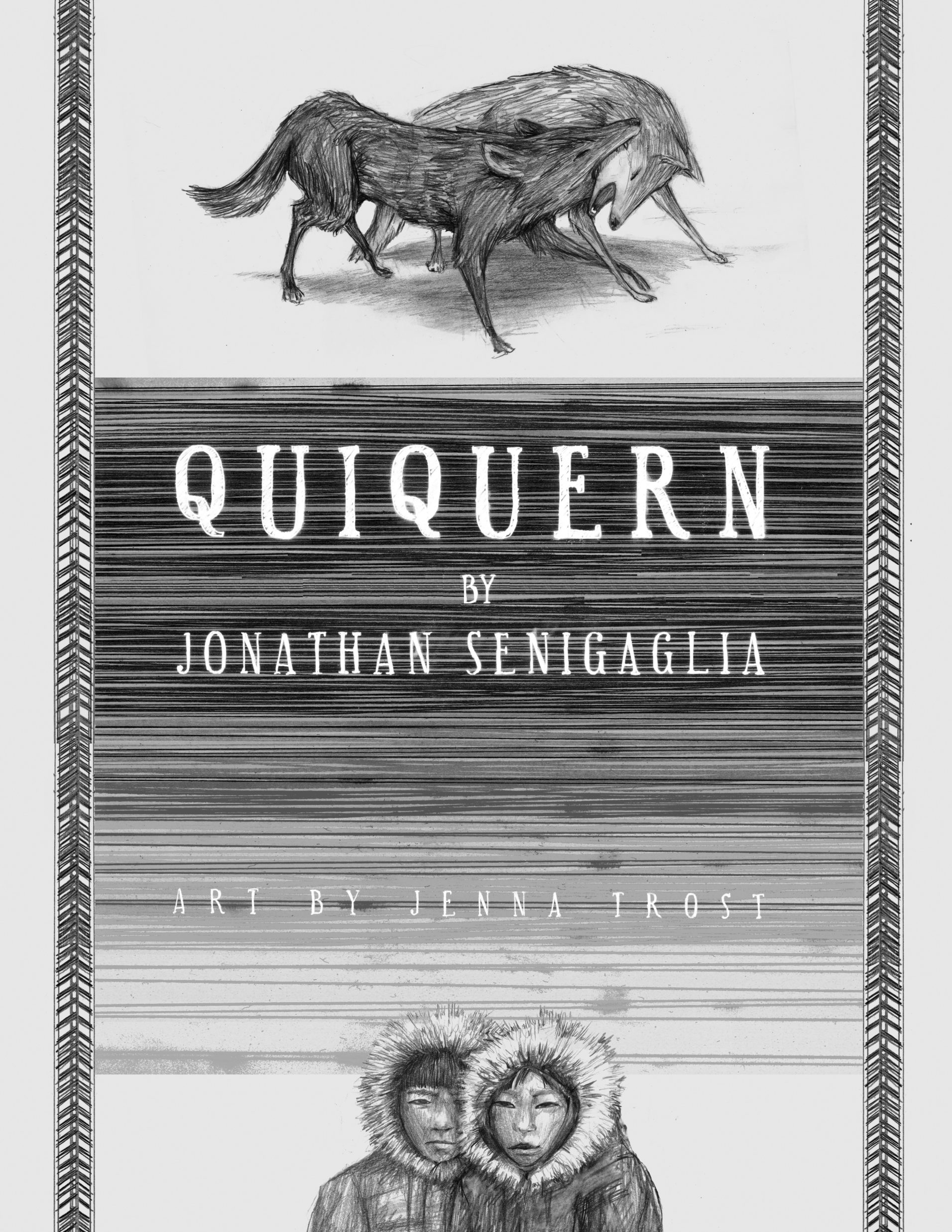
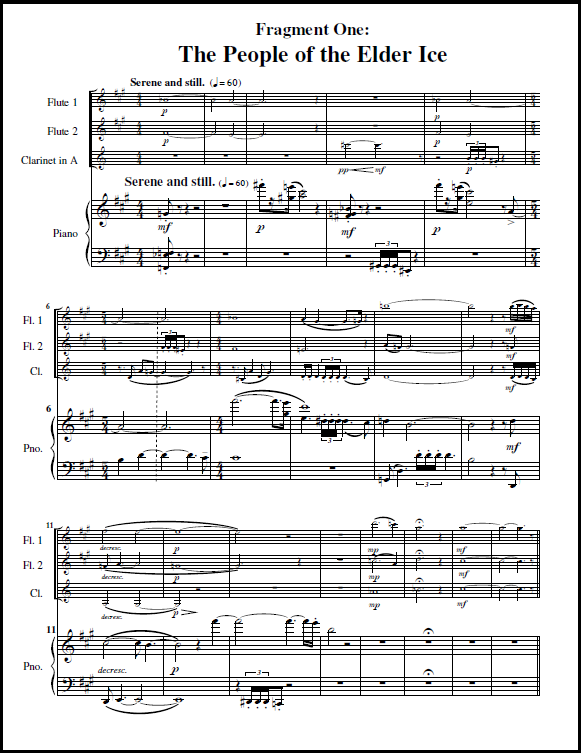
Have a listen while you read:
One of my favorite short stories of all time is “Quiquern” by Rudyard Kipling, from The Second Jungle Book. If you’ve never read the two Jungle Books, I highly recommend them. The Disney film only scratches a tiny surface compared to the epic stories by Kipling (Mowgli’s story is really only the first of like 20 stories). The writing is so crisp, and these stories do what all great sci-fi and fantasy stories do: they create an entire fully-formed world for the reader to explore. The world is rich and complex, and the lessons it teaches are piercing and difficult to shake.
The Disney film is fun and jazzy and hip and carefree; the written stories are raw and wild, filled with the brutal poetry of the jungle. The characters are bound by the laws of the jungle, the unwritten rules and shared understandings that guide every action the animals take. The laws dictate how to behave in times of drought, when and where hunting is permitted, and how to interact with the ever-expanding, dangerous world of Men. Only Mowgli is unbound by the laws of the jungle. Therefore he rules the jungle.
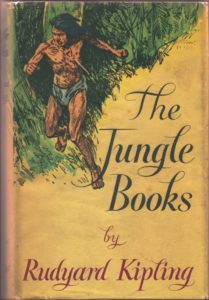
There are also so many hidden messages and deeper meanings packed into Kipling’s verse. Every story begins and ends with poems, the meanings of which change after reading each story. For example, this one:
And his own kind drive us away!
At first reading, it is a nice little poem. But after reading the story that follows it, “The Miracle Of Purun Bhagat,” the poem becomes so tragic and beautiful. Every story has these lovely little nuggets, and they make the reading experience so rich.
“Quiquern” is the story of a young Eskimo boy who lives in a tiny village surrounded by a frozen arctic wasteland. The village’s only source of food is seal meat which they catch with the help of their many well-trained dogs. One particular dog is born a runt, shrunken and sickly in the freezing wind. However the young boy cares for the dog, and raises him as a member of his own family. His love for the dog is pure and innocent, and together they frolic in the snow like siblings.
One year the winter is especially harsh, and the ice does not recede. The surplus seal meat runs out, and the people of the village soon begin to starve. In their moment of desperation they eat the wax from their candles, the leather from their belts. Their beloved sled dogs, still chained together in groups of eight, insane with hunger and fearing for their lives (just as lion cubs must fear their mother in times of hunger) break their chains and run screaming into the white waste. The people of the village become living skeletons.
The boy and a young girl from the village, still strong in their youth, announce to the village that they will venture out into the ice storm and find food for the village. It is suicide, but nobody stops them. Within days of their departure they are hopelessly lost, freezing, and beginning to hallucinate. They kneel shivering in the snow and announce to the heavens that they are man and wife. As darkness closes around them they pray to Quiquern, the eight-legged spider god of the arctic, for salvation and mercy.
The two children open their eyes to see a massive creature barreling toward them in the distance, eight legs scurrying effortlessly across the snow. A giant, hulking body becomes larger and larger in the morning haze. Quiquern has arrived to devour them; they are helpless as newborn seals. It is the end of their short lives, the end of their people. Two freezing, starving children prepare to die alone on a frozen plain at the edge of the world.
However as their eyes focus, they realize that the eight-legged creature is actually two dogs, running wildly through the snow pulling an empty dogsled. The dogs are well-fed and excited, blood dripping from their snouts. At the front of the pack is the runty dog the young boy once saved, frothing with joy at the sight of his oldest friend.
Carried by the sled dogs, the two Eskimos travel for miles to an open pit in the ice, where fat seals emerge for air. The dogs had found the hole in the ice and gorged themselves on meat. The boy and his wife fill the sled with food and return to the village as heroes. The village, now inhabited only by ghost-like creatures with sunken eyes, celebrates by burning whatever candles they have left. An ancient people go on.
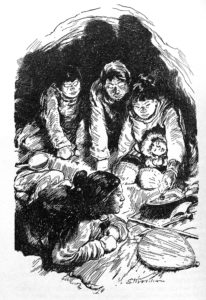
This story burrowed down inside me and left its mark on my soul. I’m not sure why, I can’t explain it, but it filled me with the urge to write music. Originally I set out to write something eerie and cold and empty, three flutes crying out across the Arctic plain. But as I wrote, I realized it needed some bass, so I worked a piano into the mix. Years later, I switched out a flute for a clarinet to give it one more color, and that ensemble is the one that remains.
I’ve always loved my piece, Quiquern, just as I’ve always loved the story Quiquern. I can’t exactly say what it is that draws me to both, but drawn I am. Over the years I’ve written notes about this music in the margins of my journal: “Don’t forget, you love Quiquern. Don’t discard it.”
The artwork at the top of this post is by the very talented artist and sculptor Jenna Trost. Please visit http://jennatrost.com/ to see more of her lovely work.
The music you’ve been listening to is the completed first movement of this work, which is called “The People of the Elder Ice”. I hope you’ve enjoyed it. The entire middle section of this movement, which I refer to as “Village Dance,” was actually added later. Read about that addition here. For Part Two: “The Dog Sickness,”Click here.